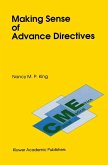The first time I read the medical consent and authorization. it had registered in my mind simply as a legal document. Now I began to understand what it meant. It was a letter of ultimate love and trust. (Schucking. 1985. p. 268) Ever since Karen Ann Quinlan slipped into permanent unconsciousness in 1975 and her father agonized publicly over whether she should remain indefinitely on a respirator (In re Quinlan, 1976), the desires of patients, their families, and their friends to limit the application of apparently limitless medical technology have been a pressing concern for ethics, law, and public policy. Ms. Quinlan's case contained nearly all the elements of the problems we still face: vague, general, but sincere prior oral statements suggesting that she would not want continued treatment; a family attempting to do what they saw as best for her; and physicians uncertain whether to use medical judgment alone (and if so, what the "right" medical decision was), to preserve her life at all costs, or to honor the family's interpretation of their daughter's choice. Most ironically, once she was removed from her respirator, she did not die. Karen Quinlan - like dozens of other names made famous by court decisions, newspaper stories, and television evening news - has come to symbolize a tangled knot of issues surrounding the end of life and who controls it.
Hinweis: Dieser Artikel kann nur an eine deutsche Lieferadresse ausgeliefert werden.
Hinweis: Dieser Artikel kann nur an eine deutsche Lieferadresse ausgeliefert werden.
' Making Sense of Advance Directives is the best single book on this timely topic. It should be not only in the collections of academic libraries, but also in those of community and hospital libraries and in the reading rooms of ethics committees and clinical departments.' -- Medical Humanities Review 6:2 1992
' Making Sense of Advance Directives is the best single book on this timely topic. It should be not only in the collections of academic libraries, but also in those of community and hospital libraries and in the reading rooms of ethics committees and clinical departments. ' Medical Humanities Review 6:2 1992








